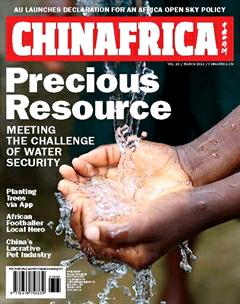Valuable Waste
By+Ge+Lijun
Just a few months ago, M. Barisco Alfonso knew nothing about biogas. Today, it is an essential part of his job as a technician in the Agricultural Directorate of S?o Tomé and Príncipe.
It all started on May 9, 2017, with the arrival of a group of Chinese experts, whose task was to assist the country in developing its agriculture. When he first met with the Chinese team, Alfonso said he wanted to learn more about biogas. Chinese technician Liu Xuan, a recognized expert in the field, gave him a firm answer immediately, “If you want, I can teach you all about it.”
Without a moments hesitation, Alfonso agreed, not knowing that this mission would entail a number of challenges, for himself and for Liu.
Useful waste
On December 26, 2016, China and S?o Toméand Príncipe renewed their diplomatic relations. Only 20 days later, an agricultural cooperation project was launched between the two countries, with China deciding to send an eight-member expert team to S?o Tomé and Príncipe, including Liu, a biogas expert.
During the first two months, Liu and his partner Alfonso conducted extensive research across the island country with the help of local governments to find a suitable location for the construction of biogas tanks. At the end of their research, they settled on two locations.
Arlindo Gé is a wine maker based in Lobata District of S?o Tomé. His factory, whose distillation process was fueled by wood, was chosen to demonstrate the efficiency of biogas. He was skeptical at first, mostly because he had never heard of biogas. The same thing was true for the second location, where Eufemeo da Gra?a, a pig farmer, was not too keen about using biogas. Despite their skepticism, the two men ended up approving the construction of biogas tanks.
With both locations now secured, training began. In fact, Alfonso was not the only one to learn this new technique. A total of 90 people studied theoretical knowledge and received practical training, which included the basic skills of biogas production. Liu and his students built the two tanks together. According to Liu, a 15-cubic-meter tank is enough to supply biogas for cooking for about 10 people.
As the project progressed, Gra?a became more and more convinced that biogas could be useful for his business. Previously, the manure of his pigs was simply discarded. Now, it is collected in the biogas tank to produce gas that can be used to fuel his kitchen. After a while, the manure can also be used as fertilizer for helping grow vegetables.
“Biogas did not exist here and many people did not believe that this technique could be developed. It was, therefore, necessary to put up a demonstration in order to show them concrete results,” Liu told ChinAfrica.
According to him, the use of biogas can also have a positive impact on the environment. Many pig breeders do not have an enclosed pigsty, and manure is lost as it runs off with the rain. “This is not healthy because it attracts mosquitoes and flies that carry contagious diseases, such as malaria,” said Liu. This waste is now being collected and used, which also helps clean the environment.
The moment of truth for the project came on January 7 this year. S?o Tomé and Príncipe Prime Minister Patrice Trovoada visited one of the locations. In front of a brand new stove, he pushed a switch, immediately lighting up a bright flame - powered by biogas - amid a burst of applause.
Overcoming challenges
In China, building a biogas tank takes about 10 days, but in S?o Tomé and Príncipe, it can take up to 30 days. “This is due to a shortage of materials, such as cement and steel,” said Liu. However, the biggest challenge is the pigsty itself, a critical part of the process.“We can see a strange phenomenon: those who raise pigs often do not have a pigsty, while those who own a pigsty do not raise pigs,” said Liu. In fact, local people are used to raising pigs in the open, which brings difficulties in collecting pig manure. On the other hand, the cost of building a pigsty is so high that often there is no money left to buy pigs once the building is completed. According to Liu, the technology of building pigsty in Chinas rural areas can be used here, which cost much lower.
“Our agricultural cooperation is based on the transmission of skills,” he said, adding that the habits of local residents will evolve as cooperation develops.
Liu will return to China in April 2018, when the second team of Chinese agricultural experts to the country will take over. After months of training with Liu, Alfonso now knows how to build biogas tanks and understands the relevant theories.
“What we want to do is to train more technicians in biogas like Alfonso. Their mastery of biogas techniques is an example of sustainable cooperation between China and S?o Tomé and Príncipe. When I leave the country, they will be able to build their own biogas tanks and master the ecological farming system. Thats the real success of our cooperation,” Liu concluded.

